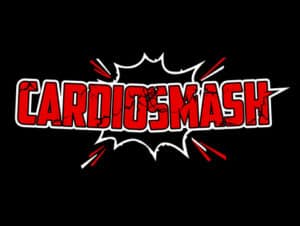If you’re like me, you like to do bodyweight squats at home to give your legs a good pump in between trips to the gym. The bodyweight squat is one of the best (and simplest) resistance exercises that you can do. In fact, even if they were the only resistance exercise you did you could still be in pretty good shape. But what happens when they get too easy? How can you make your squats harder without adding additional weight?
When you have maxed out the effectiveness of your squats you have a few options to increase the intensity of this fantastic bodyweight leg exercise. One way is to graduate to plyometrics, or jump training. The squat-jump-to-stabilization is an excellent way to take it to the next level. After warming up thoroughly with bodyweight squats, try this. Squat down to 90° at the knees, explosively launch yourself up into the air in a powerful jump as high as you can, extending your arms overhead. Then land and bend your knees back to the starting position. Pause here for 3-5 seconds, and then repeat. This exercise will build explosive power, improve your balance, and provide greater resistance (in the concentric and eccentric portion, and adds an isometric hold) to build muscle mass.
Is this appropriate for everybody? Isn’t the impact harmful? What if you’re older? There are other options available, but let’s discuss that and also some of these other questions.
How do I do a squat jump with stabilization?
This exercise is fairly straightforward. If you are already doing squats you’re basically just tweaking those and adding a jump.
The squat jump with stabilization is performed as follows:
- Stand with feet spaced about shoulder width apart. Toes pointing forward, or in their natural position. Hands by your sides, head up looking straight ahead.
- Squat down until your knees are bent to a 90° angle. Flex your elbows to bring your hands up in front of your chest.
- Explosively jump as high as you can while stretching your arms above your head. Remain facing and looking forward.
- Land with your ankles slightly dorsiflexed (bent upwards), knees and hips bent, slow your descent as you return back to starting position.
- Hold this position for 3-5 seconds.
- Repeat.
The jump requires more upward force than a traditional bodyweight squat. This is the concentric contraction part of the exercise.
The landing requires your body to handle far more force than simply lowering your bodyweight. This is the eccentric portion of the exercise, which is greatly increased by these greater forces.
The static hold at the bottom of the landing will challenge your proprioceptive systems and strengthen your joints and stabilizing muscles. This is an isometric portion, where the muscle doesn’t continue to contract but cannot release either. Isometrics are often overlooked but have the potential to give you a great workout. Remember wall-sits from gym class?!
It is important to warm up thoroughly before doing the squat jump with stabilization. I would suggest 10-15 mins of light cardio followed by a few sets of bodyweight squats to be sure to limber up and get the muscles ready for the forceful contractions ahead.
My knees are bad should I still do jump squats?
If you have knee problems, ankle problems, or any type of injury you should not start doing this or any type of plyometrics without getting the approval of your doctor. In fact, even if you are healthy, but new to exercise, get a checkup with your medical professional before starting this or any other exercise program.
While, if performed properly, the impact itself should not be harmful, it could aggravate pre-existing weaknesses or underlying injuries.
Also, if you are particularly heavy (overweight) you’ll want to work on losing weight and slowly working your way up to this type of exercise. Start with cardio and bodyweight squats and progress as you are able.
What are the benefits of squat jump to stabilization and other plyometrics?
The benefits of squat jump to stabilization are many. Squats are one of the best exercises you can do to develop your lower body and they, alone, can really help develop your legs.
Squat jumps, and plyometrics in general, will increase your power. Power is the ability to combine strength and speed to produce maximal output in minimal time.
This is the primary goal of plyometrics for many trainees. The explosive power that you can develop by this type of training can be helpful in many sports, from (American) football to tennis.
Plyometrics has many benefits, including:
- Improves your ability to dynamically stabilize, reduce and produce forces in a functional environment
- Decreases reaction time
- Increases rate of force production
- Builds muscle mass
- Activates near 100% of the fibers of the affected muscles
- Burns more calories than squats
- Improves the cardiovascular system
- Improves balance
- Enhances coordination
- Increases jumping ability
Furthermore, when you combine resistance training and plyometrics, the benefits are dramatic, as this study shows. So keep doing your regular bodyweight squats too.
There are a wide variety of plyometric exercises that you can perform besides squat jumps. As you progress and see the results that come from this type of exercise, you may want to add some box jumps or jump downs to your leg training, or medicine ball throws for your upper body. Here is an example of a good box for plyometrics and a quality medicine ball from Amazon.
How else can I make my squats harder?
Besides using weight in the form of a barbell, dumbbells, or resistance bands, there are a ton of variations on the basic body weight squat that you can do to make the exercise more challenging.
Prisoner squats.
These are exactly the same as regular body weight squats except that your hands are clasped behind your head. This alters your posture and makes your body weight squats more like front barbell squats. Realigning your spine to be more upright, the focus is shifted to the lower quads, namely the vastus medialis. This teardrop-shaped muscle is right above the knee and is the most visible part of the quadriceps.
Bosu ball squats.
When you balance on top of a bosu ball you are in an environment of controlled instability. This forces your body to have to struggle to maintain balance. This proprioceptively enriched activity will strengthen and stabilize your joints and make doing squats much more challenging.
Foam pad squats.
Doing your squats is another example of controlled instability, which will make your squats much harder and provide more benefits than doing them on a flat surface.
Sissy squats.
With one hand, hold on to a sturdy piece of equipment or furniture to maintain balance. Then bend at the knees and squat down to 90° while keeping the thighs and torso aligned straight. This is a very challenging exercise that will really get your quads burning. The glutes are far less involved and the hamstrings are not utilized as much, but your quadriceps can really benefit from this exercise.
Single-legged squats (with top leg planted).
This is a great entry-level single leg squat. Place one foot on a bench, short stool or other sturdy object about knee height. Slowly squat down with the weight bearing leg as far as is comfortable. Be sure to stop descending as soon as your form gets shaky. Straighten back up and repeat. This variation is a good transitional step between two- and one-legged squats because your body’s stability system is stimulated well, but the level of instability is less than with other, unsupported single leg squats. Also, while there is only one leg doing the work, some of your weight is supported by the bench so it’s not as hard as some other one-legged squats.
One legged squats.
This basic single leg squat is performed with the non-weight bearing leg flexed at the hip with the thigh slightly raised and the lower leg hanging straight down. This way you are moving all of your body’s weight with one leg, while also working in a proprioceptively enriched environment which will improve your balance and strengthen your joints and improve synergy.
Pistol squats.
This is another single-legged squat, except with pistol squats the non-working leg will be extended forward (giving your body the vague appearance of a pistol – hence the name). This is far more difficult than any of the above variations. Holding your leg out in front of you will make it even more challenging to balance. This is an advanced movement and, to start, you may need to hold on to something to help you maintain balance and for a slight assist until you become strong enough to perform this exercise properly.
Super-slow reps.
Performing your squats, and any variations of them, at a slower pace will make them much more challenging. This will make the negative portion (eccentric) more difficult and will create more microtears in the muscle fibers, leading to more muscle growth.
While plyometrics require explosive fast contractions and lead to greater forces in the negative due to gravity, (super) slow reps will also work the muscles differently than normal paced squats.
So, we have discussed a few ways to alter your squat workout to get more out of this basic but indispensable leg exercise. Whatever variations you try to remember to warm up well and push yourself. Keep doing traditional squats too, and you’ll combine the plyometric approach of squat jumps, as well as the stabilizing required in the squat jump with stabilization, with benefits of regular resistance training for power, strength, fast reaction speed, joint stability, and many others.
Related posts:
Can squats be considered cardio?
Squats are a resistance exercise primarily designed to strengthen and build the muscles of the lower body. As anybody who has ever done squats will tell you, it is not something that most people can do continuously for a long period of time. It’s too difficult. Comparing squats to a typical cardio exercise like jogging is like comparing push-ups to dribbling a basketball. However if you structure your squat workout the right way, it can resemble cardio and have some of the same cardiovascular and fat loss benefits.
Can running hills make my legs bigger?
Running uphill provides a highly effective workout and can definitely help you achieve a number of fitness goals. If your goal is to build more muscular legs then you should absolutely add some hill runs to your fitness regimen, as this activity is a tremendous leg workout that will seriously tax your quads, calves, glutes and hamstrings. Rather than running for a certain amount of time over some hilly terrain, concentrate on hill sprints. Sprinting up a small-to-medium hill, then walking back down to repeat, is a form of high intensity interval training and will not only build powerful legs but will also help get you shredded by putting your metabolism into overdrive!


